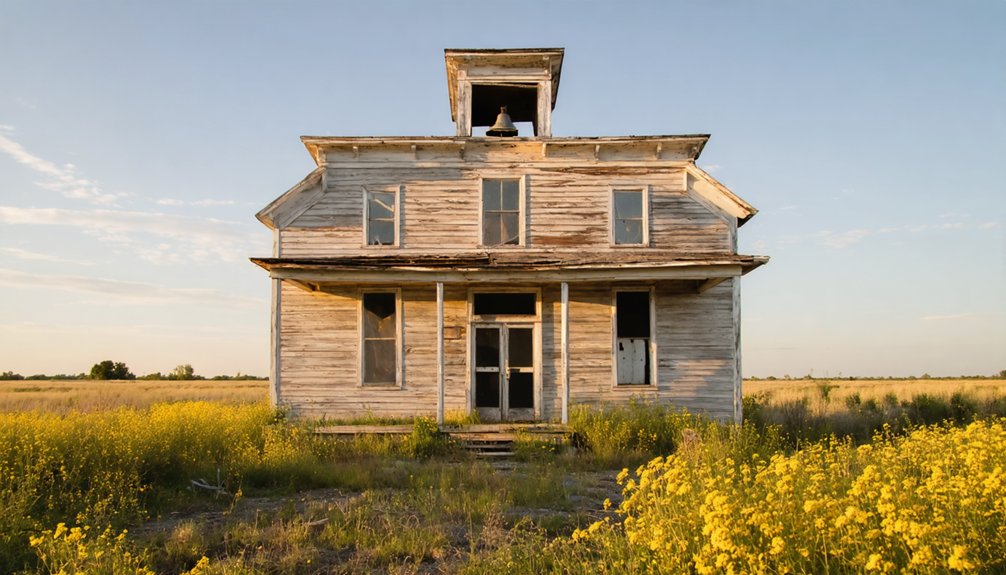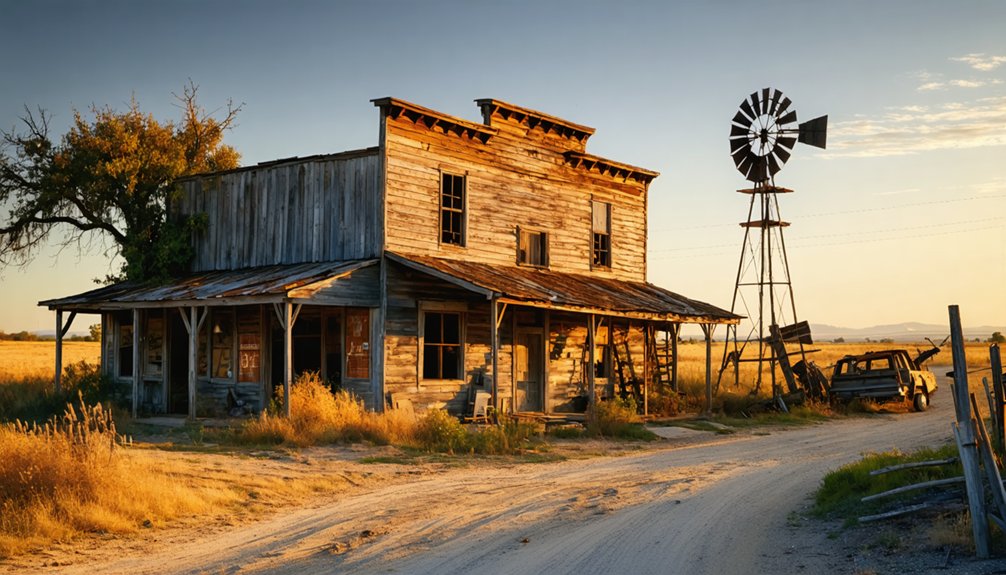In Wilson County, you’ll find Denhawken, a ghost town born from German roots in 1895. Three founding families – the Denmarks, Hawks, and Steenkens – donated land along the San Antonio and Gulf Railroad, creating a thriving farming settlement. The community peaked in the 1940s with 75 residents before post-war urban migration led to its decline. Today, empty storefronts and an old community center tell a deeper story of Texas’s rural transformation.
Key Takeaways
- Denhawken became a ghost town after its peak population of 75 residents in the 1940s declined due to post-war urban migration.
- Founded between 1895-1905 by German settlers, the town was named after three founding families: Denmark, Hawk, and Steenken.
- The community thrived around its central schoolhouse, which later became a community center for local gatherings and events.
- By the 1980s, only two stores and one church remained as farm bankruptcies and low crop prices devastated the local economy.
- Located in Wilson County, Denhawken is one of thirty-one ghost towns in the area, preserving German cultural heritage through its remains.
The Birth of a German Settlement (1895-1905)
When the San Antonio and Gulf Railroad extended its reach through Wilson County in the late 1890s, German farmers saw an opportunity to establish a new settlement about 14 miles east of Floresville.
These early settlers, including families like the Denmarks, Hawks, and Steenkens, brought their agricultural practices from established German communities in Texas and the Midwest. Their story became part of local Texas history, which remains significant to residents today.
You’ll find they weren’t alone in this frontier venture. Polish and Mexican American families joined them, creating a diverse but primarily German community.
The settlers quickly organized their new home around a central schoolhouse, with farms spreading across a 3.5-mile radius. The town’s name “Denhawken” came from combining the surnames of three land-donating founders.
They held onto their German language, customs, and farming traditions, while the railroad’s presence guaranteed their crops could reach broader markets, helping the community thrive.
A Name Born From Three Founders
The story behind Denhawken’s unique name showcases the collaborative spirit of its three founding families.
You’ll find the town’s identity woven from the surnames of D.C. Denmark, W.L. Hawk, and Charles Steenken, who each contributed three letters to create this distinctive portmanteau.
Their founders’ collaboration typified the strong sense of unity among German settlers in late 19th-century Texas.
The community thrived within a three-mile radius from the central schoolhouse, bringing together numerous pioneering families.
The town’s cemetery, founded in 1904, became a lasting testament to the early settlers’ presence in the area.
Life in Early Denhawken
Life in early Denhawken centered around a close-knit community of German farmers who settled the area between 1895 and 1898.
You’d find families like the Denmarks, Hawks, and Steenkens working the land, with Polish and Mexican American neighbors adding to the town’s character. Much like Thurber’s immigrants, these workers often faced language barriers when communicating with each other. The community thrived during westward expansion, as did many other Texas towns during this industrious period.
The community’s heart beat strongest at the schoolhouse, where you could join local events and gatherings just 3.5 miles from any direction.
The Community’s Golden Years
During the mid-1940s, Denhawken reached its peak with roughly 75 residents calling this Wilson County settlement home. You’d find a tight-knit community of German, Polish, and Mexican American families working together to preserve their Denhawken heritage. German farmers first arrived between 1895 and 1898, establishing the foundations of this close community.
The town’s spirit centered around their schoolhouse-turned-community hall, where neighbors gathered to celebrate and support each other. With two stores and two mills, plus the San Antonio and Gulf Railroad nearby, folks enjoyed both self-sufficiency and connection to the wider world.
- The Denmark, Hawk, and Steenken families’ legacy lives on in the town’s very name
- Local mills processed the fruits of their farming labor right there on home soil
- Community resilience showed in how families donated land for shared spaces
- Railroad access meant freedom to trade and travel while maintaining rural roots
- The schoolhouse served as the heart of local culture and education
From Farmland to Ghost Town
You’ll find Denhawken’s origins tied directly to the San Antonio and Gulf Railroad’s arrival in the late 1890s, which drew German farmers to establish roots in this fertile Wilson County soil.
Like the thousands of European immigrants who settled in Thurber to work the coal mines, the German settlers brought their agricultural expertise and community-focused farming practices, helping the town grow into a modest but stable farming settlement with mills and stores by the 1930s.
After reaching a peak population of 75 residents in 1947, Denhawken couldn’t sustain its farming economy, and the community gradually faded into one of Wilson County’s many ghost towns. Today, it stands as one of the thirty-one ghost towns that dot Wilson County’s landscape.
Railroad Spurs Initial Growth
The arrival of the Houston and Texas Central Railway in 1872 transformed vast stretches of North Texas farmland into bustling commercial centers, including the small settlement that would become Denhawken.
You’ll find that railroad expansion played a vital role in the town’s development, connecting local farmers to wider markets and reducing their shipping costs. The Texas Legislature mandated that all railroads must incorporate within the state before beginning construction.
The rail connection didn’t just move goods – it brought new settlers, materials, and economic opportunities that sparked Denhawken’s initial growth.
- Watch how a simple rail line turned isolated farmland into a thriving trade point
- Feel the excitement of those first train whistles echoing across the prairie
- Experience the pride of local farmers finally reaching distant markets
- Imagine the celebrations as the first locomotive rolled into town
- See the transformation as agricultural shipments brought newfound prosperity
German Agricultural Settlement Patterns
German families flocked to Denhawken’s fertile farmland in the 1870s, drawn by the Adelsverein society’s promise of 320-acre homesteads and fundamental farming infrastructure.
You’d find these pioneers settling in small clusters, establishing farms near essential water sources while maintaining enough distance between neighbors to work their land effectively.
Their settlement strategies centered on building community structures like schools and churches near their farmsteads, creating tight-knit support networks important for survival.
These German settlers adapted their agricultural methods to Texas’s unique climate, growing corn as a staple crop while raising livestock on the open range.
They’d share labor during planting and harvest seasons, pooling resources and knowledge to overcome the challenges of farming in their new homeland.
The community’s success hinged on this balance of independent farming and cooperative spirit.
Post-1947 Population Decline
While Denhawken once thrived as a farming community with 75 residents in 1947, its transformation into a ghost town mirrored the broader exodus from rural Texas in the post-war era.
Population trends show how urban migration drained the town’s lifeblood as folks traded their cotton fields for city jobs. By the 1980s, you’d find just two stores and one church standing as evidence to what once was.
- You can’t help but feel the heartbreak of German, Polish, and Mexican American families leaving their farmland dreams behind.
- The town’s vibrant cotton economy withered as farm bankruptcies and low crop prices took their toll.
- Empty storefronts tell the story of a community that couldn’t keep its young people from seeking opportunity elsewhere.
- Each departure weakened the town’s cultural fabric and social bonds.
- Denhawken’s story reflects hundreds of Texas farming communities that couldn’t survive the changing times.
Legacy in Wilson County’s History

You’ll find few ghost towns with a name origin as unique as Denhawken’s, where three founding families – Denmark, Hawk, and Steenken – saw their surnames combined to create the community’s identity in 1905.
As one of Wilson County’s thirty-one ghost towns, Denhawken stands out for its strong German cultural heritage, which shaped local farming practices and community traditions alongside Polish and Mexican American influences.
The town’s community center and schoolhouse served as the heart of local life for decades, hosting gatherings and education until its closure in 1950 marked the beginning of the settlement’s decline.
Unique Three-Founder Origin
- They donated prime land for a schoolhouse that’d become the town’s beating heart.
- You can trace their legacy in every letter of the town’s name: Den-haw-ken.
- Their bold vision attracted diverse settlers from Polish and Mexican American backgrounds.
- They established boundaries within 3.5 miles of their centerpiece schoolhouse.
- They created a blueprint for other Texas communities to follow.
- The building’s evolution from schoolhouse to social center kept Denhawken’s spirit alive
- Local families preserved their German heritage through festivals and celebrations here
- The center gave rural folks a place to discuss important county matters
- Kids who once studied here returned as adults for community events
- Even as Denhawken became a ghost town, the center remained a beacon of local identity
- http://pacweb.alamo.edu/InteractiveHistory/projects/rhines/StudentProjects/2006/Denhawken/template.html
- https://texashighways.com/travel-news/four-texas-ghost-towns/
- https://www.tshaonline.org/handbook/entries/denhawken-tx
- https://www.youtube.com/watch?v=phjUE19A8HM
- https://www.ksat.com/holidays/2018/10/30/texas-has-more-ghost-towns-than-any-other-state/
- https://www.kut.org/texas/2017-10-30/boo-the-rise-and-fall-of-texas-ghost-towns
- https://en.wikipedia.org/wiki/List_of_ghost_towns_in_Texas
- https://www.texasescapes.com/SouthTexasTowns/Denhawken-Texas.htm
- https://www.wilsoncountyhistory.org/talk-denhawken
- https://cedarbayoumarina.com/four-ghost-towns-under-lake-texoma/
German Settlement Impact
German settlers left an indelible mark on Wilson County’s development, particularly through their agricultural expertise and community-building skills. You’ll find their influence in the farming techniques they adapted to Texas soil, establishing productive farms and mills that boosted the local economy.
In Denhawken alone, their population reached 75 by the 1930s.
Their cultural preservation efforts created lasting institutions like dance halls, shooting clubs, and schools that shaped Wilson County’s character. They brought *Gemütlichkeit* – their spirit of warmth and hospitality – while maintaining positive relationships with other communities.
Their dedication to education led to the establishment of schools that served as cultural hubs. Even as Denhawken’s population declined, the German settlers‘ self-sustaining farming traditions helped preserve the rural landscape you see today.
Community Center Significance
While many rural Texas communities gradually faded into history, Denhawken’s Community Center emerged as an indispensable cornerstone of Wilson County life.
You’ll find its legacy deeply woven into the fabric of local culture, starting as a schoolhouse before transforming into a crucial hub for community gathering and social cohesion around 1950.
Frequently Asked Questions
Are There Any Remaining Original Structures Still Standing in Denhawken Today?
You’ll find several remaining buildings, including the W.W. Cole Building, an old general store, post office, and gas station. Despite poor historical preservation, these weathered structures still stand as silent witnesses.
What Happened to the Descendants of the Three Founding Families?
By 1950, nearly all founding family descendants relocated to nearby Stockdale and Floresville. You’ll find their descendant stories woven into Wilson County’s fabric, where they built new lives seeking better opportunities.
Did Denhawken Ever Have Its Own Post Office?
You won’t find any official post office history for Denhawken. Folks there had to rely on postal services from nearby towns, usually heading over to Runge to handle their mail needs.
Were There Any Notable Crimes or Incidents in Denhawken’s History?
You won’t find any documented crime incidents or ghost stories here – records show it was just a peaceful farming community. The town’s decline came from folks moving away, not trouble.
What Crops Were Primarily Grown by the German Farmers in Denhawken?
While German agriculture shaped the landscape, you’d find cotton dominating your fields in Denhawken. You’re also looking at corn everywhere, with some rye and wheat mixed into your crop varieties.



